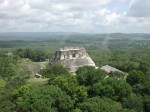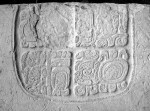 Archaeologists have discovered the tomb of a lord from the Maya Snake dynasty inside a temple at the ancient site of Xunantunich in western Belize. At 4.5 by 2.4 meters (14’9″ by 7’10”), it’s one of the largest burial chambers ever found in Belize, and is the largest royal one. It was discovered 16-26 feet underground, buried under layers dirt and debris beneath the central stairway of a pyramidal structure.
Archaeologists have discovered the tomb of a lord from the Maya Snake dynasty inside a temple at the ancient site of Xunantunich in western Belize. At 4.5 by 2.4 meters (14’9″ by 7’10”), it’s one of the largest burial chambers ever found in Belize, and is the largest royal one. It was discovered 16-26 feet underground, buried under layers dirt and debris beneath the central stairway of a pyramidal structure.
 Inside were the remains of an adult male between 20 and 30 years old when he died. He was lying on his back with his head pointing south. Initial osteological analysis found that he was fit and well-muscled with no obvious signs of disease or fatal injury. Buried with him were jaguar and deer bones, six jade beads, 13 obsidian blades and 36 ceramic vessels. Two other offering caches were found at the base of the stairway. They contained nine obsidian and 28 chert flints and artifacts known as eccentrics which are flaked and chipped around the edges like flints, but instead of having a functional design are carved in symbolic animal or plant shapes.
Inside were the remains of an adult male between 20 and 30 years old when he died. He was lying on his back with his head pointing south. Initial osteological analysis found that he was fit and well-muscled with no obvious signs of disease or fatal injury. Buried with him were jaguar and deer bones, six jade beads, 13 obsidian blades and 36 ceramic vessels. Two other offering caches were found at the base of the stairway. They contained nine obsidian and 28 chert flints and artifacts known as eccentrics which are flaked and chipped around the edges like flints, but instead of having a functional design are carved in symbolic animal or plant shapes.
While there is no direct evidence of who was buried in this tomb, it had to be someone of great importance. Maya tombs are usually “intrusive,” built into or dug out of pre-existing structures. This tomb was built inside the temple from the beginning, a very rare design in Maya architecture. Two hieroglyphic panels were also discovered, not in the burial chamber but in the central staircase, and those panels may be the most exciting part of this very exciting find.
 The Snake dynasty was one of the dominant dynasties of the Maya Classic Period (200–1000 A.D.). Its seat was the city-state of Calakmul, now in southern Mexico, but through conquest, alliances and strategic marriages, its area of influence extended south to Guatemala and Belize.
The Snake dynasty was one of the dominant dynasties of the Maya Classic Period (200–1000 A.D.). Its seat was the city-state of Calakmul, now in southern Mexico, but through conquest, alliances and strategic marriages, its area of influence extended south to Guatemala and Belize.
Xunantunich, just east of the border with Guatemala more than a hundred miles south of Calakmul as the crow flies, was founded around 600 A.D. as a subordinate of the Naranjo polity 10 miles to the west. Naranjo was at first allied with Tikal, Calakmul’s greatest enemy, but was conquered by Calakmul’s ruler Tuun Kab Hix in 546 A.D.
Tikal’s influence in the region suffered a devastating blow in 562 when Tikal’s Lord Wak Chan K’awiil (Lord Double Bird) was defeated by Lord Yajaw Te’ K’inich II (Lord Water) of Caracol, an important city 25 miles south of Xunantunich. The defeat kicked off 120 years of decline in Tikal, with significant population loss, destruction of monuments and no new buildings erected for the entire period.
Calakmul was more than glad to step into the breach. In 619, Lord K’an II of Caracol formally allied his polity to Calakmul and its mighty Snake Lords (and Lady Snake Lords). During the 40 years of Lord K’an II’s reign, Caracol grew in population, architecture and size. He also went to war with Naranjo, a former ally with a mutual Calakmul connection, no fewer than four times, killing its king during one of those wars. To celebrate his long reign and many victories, in 642 Lord K’an commissioned an elaborately carved hieroglyphic stairway at Naranjo.
 K’an II died in 658 A.D. and a couple of decades later, Naranjo reestablished its regional prominence when it decisively defeated Caracol in 680 A.D. Lord K’an’s hieroglyphic stairway was dismantled but not destroyed. Its symbolic power was destroyed, however, because most of the panels were reassembled out of order and four of them were scattered so the hieroglyphics no longer made sense and K’an’s gloating was rendered meaningless. One of the four missing panels was unearthed at the archaeological site of Ucanal in northern Guatemala. Another was found at Caracol. Archaeologists believe the two panels found at Xunantunich are the last missing pieces of the stairway, the first and the last, no less, alpha and omega. That makes it a hugely significant discovery for Mayan epigraphy.
K’an II died in 658 A.D. and a couple of decades later, Naranjo reestablished its regional prominence when it decisively defeated Caracol in 680 A.D. Lord K’an’s hieroglyphic stairway was dismantled but not destroyed. Its symbolic power was destroyed, however, because most of the panels were reassembled out of order and four of them were scattered so the hieroglyphics no longer made sense and K’an’s gloating was rendered meaningless. One of the four missing panels was unearthed at the archaeological site of Ucanal in northern Guatemala. Another was found at Caracol. Archaeologists believe the two panels found at Xunantunich are the last missing pieces of the stairway, the first and the last, no less, alpha and omega. That makes it a hugely significant discovery for Mayan epigraphy.
The panel hieroglyphs indicate the stairway was built in 642 (earlier estimates put it at 637) and note the death of Lady Batz’ Ek’, Lord K’an’s mother. Her titles suggest she was probably born in Yakha, a nearby Snake-ruled city in Guatemala, and was married to the lord of Caracol to cement their alliance.
[Epigrapher Dr. Christophe] Helmke said the panels “tell us of the existence of a king of the dynasty that was murky figure at best, who is clearly named as Waxaklajuun Ubaah Kan”. This ruler reigned sometime between 630 and 640AD, and may have been Kan’s half-brother.
“This means that there were two contenders to the throne, both carrying the same dynastic title, which appears to have been read Kanu’l Ajaw, ‘king of the place where snakes abound’,” he wrote in an email.
The panels clarify what Helmke called a “tumultuous phase of the snake-head dynasty” and explain how it splintered between cities before dominating Maya politics in the region.
The panels identify the origin of the snake dynasty at Dzibanche, in the Yucatan peninsula of modern Mexico, and refer to the family’s move to their capital of Calakmul.